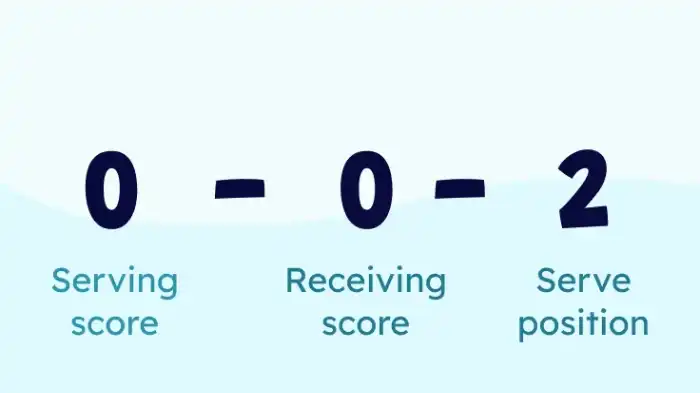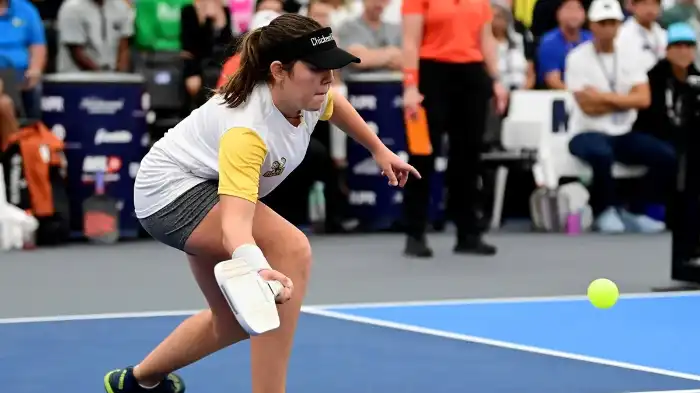Welcome to our comprehensive guide on scoring pickleball! If you are new to the sport or just want to refresh your knowledge about scoring in pickleball, you’ve come to the right place. In this blog post, we will first explore the basics of pickleball. Then, we are going to discuss what is pickleball scoring system, its terminologies, and strategies for scoring in pickleball effectively.
The Basics of Pickleball
Pickleball is a paddle sport that combines elements of tennis, badminton, and table tennis. It can be played indoors or outdoors on a badminton-sized court. The game is played with a solid paddle and a unique plastic ball with holes. Pickleball can be played in singles (one player per side) or doubles (two players per side).
The objective of pickleball is to score points by hitting the ball over the net and into the opponent’s court in such a way that they are unable to return it. To win a pickleball match, players must reach a predetermined number of points, typically 11 or 15, and have a lead of at least two points over their opponents.
How to Serve
The game begins with one side serving the ball diagonally. The serve must be hit underhand, below the waist, and from behind the baseline. The server must stand behind the baseline and hit the ball into the receiving service box on the opposite side of the court.
Just like in tennis, the serve must clear the net and land inside the diagonally opposite service box. If the serve goes out of bounds or fails to clear the net, it results in a fault and the opposing team gets the serve.
What Is Pickleball Scoring System?
The scoring system in pickleball follows a unique pattern that incorporates elements from both traditional scoring systems and rally scoring. A pickleball game consists of several smaller units called “rallies”. A rally starts with a serve and ends when a point is awarded (either to the serving side or the receiving side).

Scoring Pickleball Points
In pickleball, only the serving side can score a point. If the serving side wins the rally, they are awarded one point and the serve transfers to the receiving side. If the receiving side wins the rally, they do not earn a point but gain the right to serve next. This is called a “side out.”
Points are scored regardless of which team serves the ball. However, the serving team must win the rally to score. The first team to reach 11 or 15 points, with a two-point advantage, wins the game. It is common for pickleball matches to be played as best-of-three games.
Scoring Pickleball Terminologies
Understanding the terminology used in scoring pickleball is essential for players to track the score accurately. Here are some common terms you should be familiar with:
Server’s Score
This refers to the number of points the serving team has earned. The server’s score is always announced first during the score call.
Receiver’s Score
This refers to the number of points the receiving team has earned. The receiver’s score is always announced second during the score call.
Side Out
This term is used when the serving team loses the rally, resulting in a change of server. No points are awarded to either team during a side out.
Game Point
When one team is just one point away from winning the game, they reach “game point.” For example, if the score is 10-8, the team with 10 points is at game point.
Strategies for Scoring in Pickleball
Now that we have covered the basics of pickleball scoring, let’s delve into some strategic considerations:
Consistency and Placement
Focus on keeping your shots consistent and placing them strategically into open spaces on the court. Aim to hit the ball away from your opponents, forcing them into difficult positions and increasing your chances of winning the rally.
Serve Placement
Vary your serve placement to keep your opponents off balance. Aim to serve deep to push them back and follow up with a drop shot or a dink to catch them off guard.
Stay Calm under Pressure
In critical moments, maintain your composure and make smart shot selections. Avoid going for aggressive shots unless you are confident in executing them successfully.

Conclusion
Scoring pickleball may seem confusing at first, but with practice and a basic understanding of the rules, it becomes easier to follow. Remember to focus on consistency, placement, and staying calm under pressure for scoring in pickleball. Pickleball is an exciting and competitive sport, and mastering the pickleball scoring system is crucial for success on the court.
Frequently Asked Questions
In pickleball, scoring is much simpler and quicker than in traditional tennis. Instead of sets and games, pickleball uses a rally scoring system where each point is scored by the serving team. This means that the team that serves continues to score until they commit a fault. There are no advantages, deuces, or sudden-death points like in tennis.
In pickleball, points are scored when the serving team wins a rally. A rally is won if the opposing team commits a fault, such as hitting the ball out of bounds, hitting it into the net, or failing to hit it over the net. The serving team must win a point on their own serve to score. Once the serving team commits a fault, the opposing team becomes the serving team and has the opportunity to score.
Keeping track of the score in pickleball is relatively simple. Each team has a scorekeeper who announces the score at the beginning of each new service. The serving team’s score is announced first, followed by the opponents’ score. For example, if the serving team has 5 points and the opponent has 3, the score would be announced as “5-3.” If there is confusion or disagreement, both teams should come to a consensus and resolve any discrepancies.
In tournaments, scoring in pickleball rules may vary depending on the specific format being followed. However, the majority of tournament games are played using the same rally scoring system as regular pickleball matches. The main difference in tournaments is that games are typically played to 11 or 15 points instead of the usual 21 points in recreational play. Additionally, some tournaments may use a “win by two” rule, where a team must win by a margin of two points, which can lead to extended games and greater excitement.
The serving team in pickleball is determined by a coin toss or another method of chance. Once the serving team is established, the player on the right side of the court serves the ball diagonally to the opponent’s service court. The serve must clear the net and land within the opponent’s boundaries to be considered valid.

